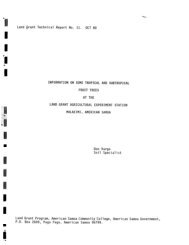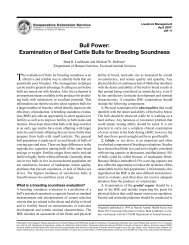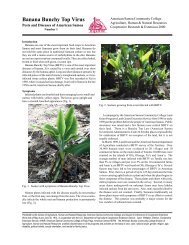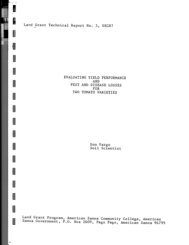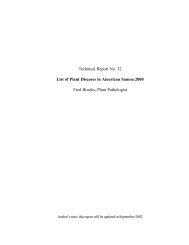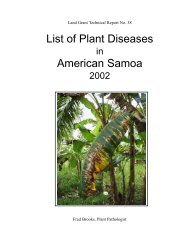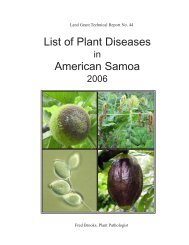List of Plant Diseases American Samoa - College of Tropical ...
List of Plant Diseases American Samoa - College of Tropical ...
List of Plant Diseases American Samoa - College of Tropical ...
Create successful ePaper yourself
Turn your PDF publications into a flip-book with our unique Google optimized e-Paper software.
ABOUT THIS TEXT<br />
<strong>Plant</strong> disease nomenclature, authorities, and modified host and pathogen index formats follow Farr et<br />
al. (1989). <strong>Plant</strong> names and authorities follow Farr (1989), Whistler (1994a), The <strong>Plant</strong> Names Project (1999),<br />
and the Index <strong>of</strong> Botanists (2001).<br />
Host-pathogen index. <strong>Plant</strong> hosts are listed alphabetically by genus and species, followed by the<br />
author who first described them. Common and <strong>Samoa</strong>n names, in brackets, follow the abbreviated author(s)<br />
names. Below each host name in alphabetical order are potential disease-causing organisms isolated from that<br />
host and the name <strong>of</strong> the disease or most common symptom. An accession number follows specimens deposited<br />
in the <strong>American</strong> <strong>Samoa</strong> Land Grant herbarium (ASLG). Most <strong>of</strong> the organisms in this list are known pathogens<br />
but may be present as saprophytes.<br />
Color plates. Between the indexes are photographs <strong>of</strong> plant pathogens and plant disease signs or<br />
symptoms. Each plate is referred to in the indexes following the name <strong>of</strong> the pathogen or host.<br />
Pathogen-host index. This is an alphabetical listing by genus <strong>of</strong> disease causing organisms followed by<br />
their authority and taxonomic classification. Below each pathogen are species identifications based on morphology,<br />
growth characteristics in vivo or in culture, signs and symptoms, isolation from a known host, or published presence<br />
in <strong>American</strong> <strong>Samoa</strong> (McKenzie 1996). Unidentified species are listed as “sp.” Each species name is followed by<br />
the host from which it was isolated and the host’s common name.<br />
Wood decay fungi. A list <strong>of</strong> macro-fungi collected by the author from 2001-2004 and accessioned into<br />
the Land Grant Herbarium (ASLG). Identifications confirmed by the USDA Forest Service, Forest Products<br />
Laboratory, Center for Mycology Research, Madison, WI, are followed by an asterisk. The list includes wood<br />
decay fungi collected by McKenzie in 1989 (PDD), and other decay fungi mentioned by him in his 1996 report<br />
(no accession numbers).<br />
Parasitic algae and their plant hosts. Five species <strong>of</strong> parasitic algae in the genus Cephaleuros and<br />
two in Stomatochroon are listed, followed by the family, genus, and species <strong>of</strong> their host(s).<br />
Fungus pathogens on insects. Several known entomopathogenic fungi have been isolated from insects.<br />
Most <strong>American</strong> <strong>Samoa</strong>ns do not use chemical pesticides and enhancing the indigenous population <strong>of</strong> insect<br />
pathogens is a potential biological control option.<br />
English and <strong>Samoa</strong>n plant names, botanical equivalents. Scientific names are given for common<br />
English and <strong>Samoa</strong>n plant names.<br />
<strong>List</strong> <strong>of</strong> host plants by family. This is a useful entry for references like Farr et al. (1986) and Whistler<br />
(1994a), where it is necessary to know plant families in order to find genus and species information.<br />
Comprehensive list <strong>of</strong> recorded plant pathogens. Most plant pathogenic fungi and bacteria recorded<br />
in <strong>American</strong> <strong>Samoa</strong> are in the publication by EHC McKenzie (1996). This list is an update <strong>of</strong> McKenzie’s<br />
publication and includes pathogenic organisms identified by the author. The latter are followed by double asterisks<br />
(**). Banana nematodes described by Grandison (1996) are followed by a single asterisk (*).<br />
Authors <strong>of</strong> plant and fungus names. Full names <strong>of</strong> abbreviated plant and fungus authorities listed in<br />
the indexes.<br />
Bibliography. <strong>List</strong> <strong>of</strong> sources used to identify plant pathogens, entomopathogens, nematodes, plantparasitic<br />
algae, and local flora.<br />
Page vi



